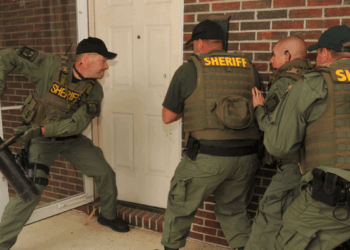
Steele Creek Presbyterian Church.
Somehow the news that the city of Charlotte, North Carolina, would soon pass the one million mark in population did not surprise me. For the past half century the city, the largest in the Tar Heel State, has longingly looked to Atlanta as something of a model, actually hoping one day to surpass it in importance and influence commercially and financially…and to leave behind forever any semblance of its history and memories as a characteristically “Southern” city.
What this has meant is that huge areas of the surrounding county, Mecklenburg, have been literally swallowed up by the encroaching metropolis. Most all traces of its rich rural history and the hardy citizens who once populated it—many whose families settled there before the Revolutionary War—seem to have disappeared, except for an occasional historical highway marker or a random mention in some business promo.
That news put me in mind of my many boyhood days in the 1950s spent with my father’s relatives in what was then a largely still-rural, still-agricultural countryside, where reminders of an earlier history yet dotted the landscape, and where folks lived on the same plots of land that their grandparents and great-grandparents had farmed.
And I also recalled the old church that had been the center around which my father’s people had gathered. For although I am a traditional Latin Mass Catholic, my Dad’s folks were hardy Scots Presbyterians who first landed in Pennsylvania in the early 1700s and then ventured south to Piedmont North Carolina. They brought with them their Protestant faith and established early on houses of worship, which became centers of their communities.
One of those was Steele Creek Presbyterian Church. Steele Creek, the second oldest church in Mecklenburg County, was founded in 1760—265 years ago.Early in the summer of 2018 Steele Creek Church closed its doors for good. The church had decided to merge with another Presbyterian Church in the area, Pleasant Hill. The Gothic revival-style brick structure was abandoned, purchased by nearby expanding Charlotte Douglas International Airport.
As late as the early 1970s Steele Creek counted 1,000 members, but the encroaching airport and the constant deafening roar of supersonic jets every moment of the day speeding off to Munich, London, Latin America and all points in between, plus the precipitous decline in the Presbyterian Church USA, which has gone the way of all mainstream Protestant denominations and embraced the liberal woke social gospel, had brought the membership down to around 350, many of them adults who held on to the memory of a Presbyterianism that once boasted of a Reverend Robert Lewis Dabney…but now could only grasp for scraps from a barren Progressivist table.
Next to the historic 1889 building is the Steele Creek Cemetery, one of the more historic burial grounds in Piedmont North Carolina, holding over 1,700 graves, the earliest from 1763, twelve years before the onset of the Revolutionary War [See: The History of Steele Creek Presbyterian Church, 1745-1978; Third Edition, Charlotte, 1978].
Steele Creek Presbyterian Church cemetery.
In that cemetery are laid veterans of every conflict and war that the American nation has engaged in: those who served during the Revolution when the then-tiny hamlet of Charlotte served as an unwelcoming “hornet’s nest” for General Lord Cornwallis; a few who went off later to fight in Mexico or against Britain again in the early Nineteenth Century; many more who joined Confederate ranks to defend the independence and rights of North Carolina in 1861-1865; then, others who fought in the great world wars and conflicts since then. But there are others, also: husbands and wives, and children, of those who had formed up until recently a close-knit, church-oriented farming community like many spread over the Tar Heel State and the South.
Since 1777 over sixty members of my father’s family have been buried in Steele Creek’s sacred ground. Six of them are direct ancestors, including my grandfather and grandmother Cathey, my War Between the States great-grandfather, Henry Cathey [13th North Carolina Regiment], and my eight-greats grandmother, Jean, who was born in County Monaghan, Ulster, in 1692, a descendant of Scots who migrated there from Ayrshire in the early 1600s.
As a young boy I recall vividly attending the funeral of my grandfather, Charlton Graham Cathey (1958), in the old sanctuary and the impressive minister John McAlpine who comforted my grandmother who would pass on four years later in 1962, aged almost 98.
Those events remain engraved in my memory, even to the point of recalling the Protestant hymns sung—“How Firm a Foundation” and “Blessed Assurance,” two of granddad’s favorites.
But most of all, I remember that remarkable church, its strong and impressive brick structure, that aura associated with and radiated by it, which deeply connected it to the history of old Mecklenburg County, to North Carolina, and to the land and families who settled nearby, and for which it was the center of their lives for generations.
The cemetery remains in church hands, despite the shrinking congregation having departed. It is too historic, so despite some earlier efforts by the airport authority to have the graves moved, it will remain where it is for the foreseeable future. But the old 1889 structure, its brick walls and interior now silent, is deserted, owned by the airport, serving only as a disappearing memory for those who care to recall what it once meant to so many. Although the city originally designated the remaining church structure a protected historical landmark, just recently the city altered that status and expropriated twenty-three nearby acres for industrial development.
In 1904 essayist and polyglot Henry Adams, scion of the fastly extinguishing Adams family of Massachusetts, authored a marvelous little volume, Mont Saint Michel and Chartres. In it he contrasted the accomplishments of the modern age, its spirit and objectives, with those of the high Middle Ages, in particular the great works of sublime architecture created during that period. While for modernity its symbol was the dynamo, the unthinking, whirring and cold mechanical devices increasingly dominating the landscape, for the Middle Ages its endearing symbol was the Blessed Virgin, Holy Mary, whose sublime tenderness and inexhaustible love for the Faithful inspired such miraculous structures as Chartres Cathedral. Adams expresses this with a certain irony, contrasting our modern fascination with and hypnotization by machines (and now with an inhuman, impersonal technology) with the Blessed Virgin as Heavenly Queen whose centrality, reality and endless bounty are manifested exuberantly in such cathedrals. Noting the devotion to Her as our champion before the Throne of God he writes: “True it was, although one should not say it jestingly, that the Virgin embarrassed the Trinity; and perhaps this was the reason, behind all the other excellent reasons, why men loved and adored her with a passion such as no other deity has ever known …” And why she sparked such incredible creativity which mirrored that devotion and faith.
Steele Creek Church still stands as the supersonic machines speed off overhead from Douglas airport to Europe, Latin America, or maybe Cancun. In a way, like Chartres compared to the modern dynamo, there is no greater contrast than what has happened to the million-person city of Charlotte, and the remembrance of a heritage and inheritance that Steele Creek incarnated and reminds us of. Modern Charlotte and its airport make stark comparisons with the haunted walls and ancient graveyard of Steele Creek. For in the bustle of the metropolis and the incessant noise of the jets there is little memory of who we were as a people, little connection to our rich historic culture.
In the late 1950s “the Queen City” that I remember as a boy was where older families yet predominated, where my father’s people were neighbors to the families of Billy Graham and Randolph Scott, where folks could recall the area’s history. Charlotte and Mecklenburg County were still linked strongly to their traditions. Now Charlotte rivals Atlanta as a mega-metropolis, and a soul-less anthill of business, banking and international commerce, with little room for heritage, except as a veneer to attract an occasional tourist not going to a Carolina Panthers game or to some big event at the coliseum.
I forget who said it—perhaps Faulkner, maybe Louis Rubin, I cannot remember—but that if he had known what Atlanta would become today, then he would wish that Sherman had torched it more thoroughly. Given what Charlotte has become, perhaps the same sentiment might be uttered?
The last major portions of farmland out near the Catawba River that had belonged to my dad’s family since 1750 are now sold to developers and strip malls. The pre-Revolutionary War house that my father was born in back in 1908 (the last of his family to do so) is now, thankfully, preserved at the Historic Latta Plantation. But the whole region has changed radically, altered and almost unrecognizable and discordant to my memories of sixty-five years ago. Hundreds of thousands of transplants (many from up North) now make Charlotte and its suburbs home and live—if you can call it that—the frenzied life of our tawdry, commercialized age.
I am put in mind of the great Southern Regionalist writer, Donald Davidson, in his epic poem, “The Tall Men”:
This is Rupert of the House
Of Rupert, famed in history,
Pondering on his income tax,
Deducting genealogy.
Great-grandfather from a loophole
Potted Choctaws in the thicket;
Rupert, menaced by the Reds,
Scratches the Democratic ticket.
[….]
Rupert, mounting in his car
Zooms up to God in Rotary.
Grandma Rupert had ten children;
Rupert’s father begot five.
All of Rupert’s stocks and bonds
Are strained to keep one son alive.
Democracy, a fuddled wench,
Is bought from tousled bed to bed.
Bass voices in white vests defile
The echoes of great voices dead.
There are remnants of the old culture that survive, a few, but they are fast being overtaken by a triumphant “Yankee” culture which Robert Lewis Dabney warned about 150 years ago, the fear that we would, as he said, become like our conquerors of 1865. Dabney, the Old Light Presbyterian divine that he was, declared that his role was like that of Cassandra at Troy, to prophesy and speak truth, but not to be believed until too late.
My mentor Russell Kirk once told me while we were discussing the old South and the changes being inflicted on her from both without and within that “it is hard to love the gasoline station where the honeysuckle used to grow.”
Steele Creek Church and its cemetery remind us who we are and who we have been. Despite being passed by and deserted, those gravestones cry out to those who would listen and take heed.
Perhaps, then, for those who do, our watchword could be from Spanish philosopher, Miguel de Unamuno in his volume, The Tragic Sense of Life: “Our life is a hope which is continually converting itself into memory and memory in its turn begets hope.”
Is this not, then, our challenge, to keep both memory and hope alive?












